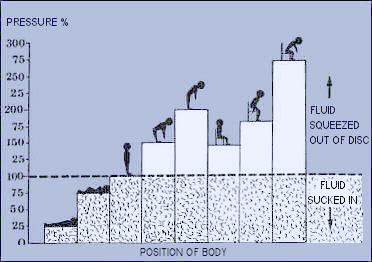What's in a Disc?
Back pain has many causes, but one of the most frequent causes is from injury of the intervertebral discs. Most people have heard of the discs in their back, or known someone who has had a slipped disc or herniated disc, or even someone who has had to have surgery on a disc in their back. But few patients I have treated really understand what the disc is, how it functions, and why it is so easily injured.
The intervertebral discs are between each vertebra. The primary function is to be a shock absorber and insulator between the bones of the spine. But they also help in maintaining proper motion of the spine. Your discs are under constant pressure. Each disc has a jelly like center called the nucleus pulposus, that is 85% water. It also contains cells called chondrocytes that make a substance called proteoglycan. This helps to lubricate the joints. The nucleus is surrounded by semi-elastic rings of cartilage made up of collagen fibers. The center jelly helps to absorb compressive forces and disperse them evenly in all directions.
The discs allow a rocking motion to occur between the vertebrae to allow your spine to bend. The vertebrae roll over the nucleus of the disc, when you bend forward the nucleus is squeezed backward, and when you bend back, the nucleus is squeezed forward. The discs are constantly under pressure, and the pressure changes depending upon the position of the spine.
The chart shows the pressure in neutral standing at 100%. When you lay down, the pressure is less, and fluid is sucked into the disc. When you are bending, lifting, sitting, or have bad posture fluid is squeezed out of the discs.. The increase in pressure is from increased muscle activation when out of a neutral position and gravity. The movement of fluid in and out of the discs from changes in pressure keeps the discs healthy and nourishes the nucleus. If there is abnormal pressure on the discs from maintaining poor postures, such as sitting at a desk for prolonged periods, fluid from the center of the nucleus is squeezed out, and nourishment of disc is compromised. Over time with repetitive, prolonged, abnormal pressure on the spine, breakdown of the cartilage and a decrease in the shock absorbency of the discs can occur. This can lead to injury of the disc, including herniation.
The best way to keep the discs healthy is to keep moving and reduce the amount of abnormal forces on the spine through correct posture and body mechanics, and maintaining a strong core. If you have back pain early in the morning, it may be due to the beginnings of disc related injury. A thorough examination of the spine, the muscles that support the spine, and identification of postures contributing to poor disc health may help prevent further injury. A physical therapist is trained to identify problems in all of these areas, and to educate the patient on minor changes they can make to their daily routines to reduce pain, improve posture, and reduce the risk of more serious disc related problems in the future.
Contact us today for an appointment and get minor back pain under control before it becomes a major problem.



